With the wintry weather not forecast to go away anytime soon and many farmers in the throes of calving season, machinery is under as much or more pressure than it has been all winter.
A functional, reliable tractor or wheel loader is vital in ensuring the smooth day-to-day running of any farm.
Often, it is during the busy winter period when issues or breakages can go unnoticed.
It is important that time is allocated at some point on a routine basis to carry out maintenance on winter machinery.
The potential consequences of poor maintenance can be catastrophic and lead to lengthy machine downtime.
Below is a guide on things one should consider when it comes to ensuring that these pivotal machines see the winter feeding season through.
1 Engine and cooling system
The engine and cooling system is always a good location to start when checking over any machine. Ensure the tractor or loader is on level ground and stopped for some time to cool, pull the bonnet and start by checking fluid levels, including engine oil and back end (hydraulic) oil. If your engine is due an oil and filter change, then now might be the time to do it.
Make a point of paying particular attention to your engine’s cooling system as this is often an area overlooked by many. Examine the condition of the water pump, fan belt (condition and tension), rubber hoses and the expansion tank or reservoir.
Check that there are no traces of oil in the expansion tank, as this would indicate head gasket failure.
Modern cooling systems use coolant, which not only helps keep the engine cool but stops the system from freezing. Coolant helps prevent corrosion, lubricates shaft seals and inhibits cavitation of components. Cooling systems on older machines may use an anti-freeze and water mix.
If in doubt about when coolant or anti-freeze was last replaced or if in excess of 12 months, it is advisable to drain and replenish. Coolant is typically a readymade solution that does not require watering down, while anti-freeze is generally a concentrate solution requiring water to be added. 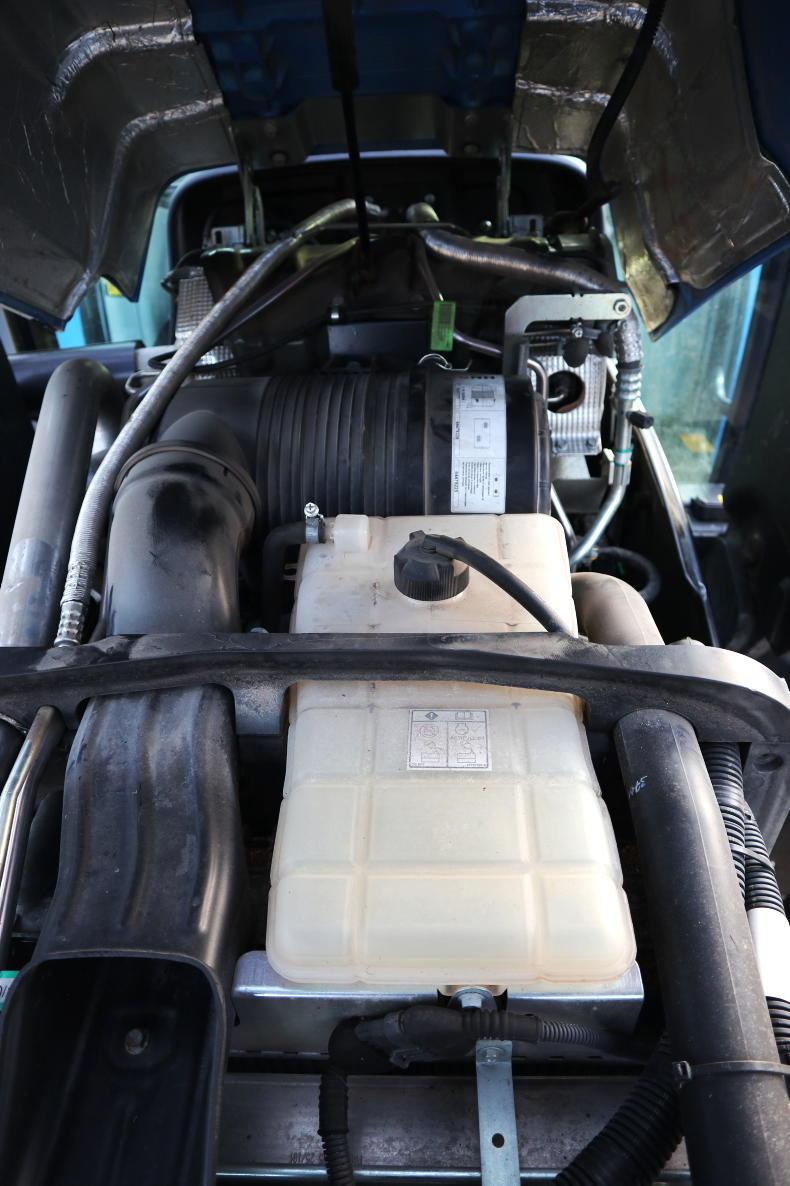
Coolant level should be checked regularly and replaced annually.
Dirty or rusty coolant indicates corrosion in the system, meaning that this particular property of the solution is no longer active, leaving the water pump susceptible to damage. It is not advised to mix different brands of coolants, as a chemical reaction could occur affecting its properties or even cause a sludge to form.
Also, check the radiator’s cleanliness regularly, as fins can become blocked with dirt and dust over time. Remove debris and blow out with an air compressor if necessary.
2 Fuel and AdBlue
Fuel filters should be replaced at the recommended intervals and the water separator drained regularly.
Fuel filters may need to be changed more frequently, depending on fuel quality. If you find this to be the case, it is worth fitting your bulk diesel tank with a pre-filter to remove major contaminants before fuel even enters the tractor or loader’s tank.
For those operating modern machinery using AdBlue, ensure the tank isn’t left full during frosty weather as a precaution. This is because the fluid can expand by up to 7%, so room for expansion is required to prevent its tank cracking. AdBlue can freeze and thaw without affecting its functionality.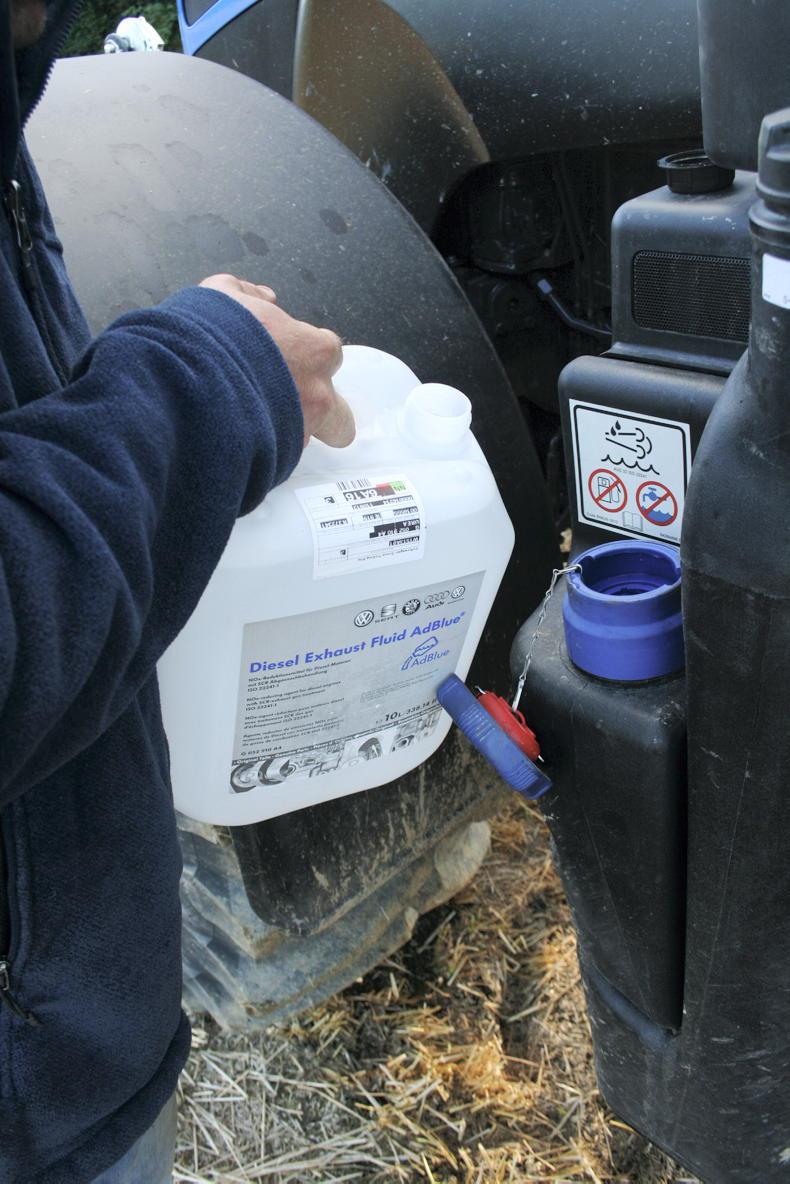
During frosty periods it is advised to only half fill machinery with AdBlue as it can expand up to 7%.
3 Battery, lighting and cab
Give the battery a quick check over, ensuring terminals are tight and free from cracks and corrosion. Any corrosion should be removed using baking soda and an abrasive brush (pole brush).
During the winter period, machines tend to run for short durations and often with lights on due to the darker days. After a period of time, the battery may lose more power than the alternator can regenerate during the time the engine runs. Before long, this will result in a flat battery.
If you find this happening, try to run the machine for longer periods every so often to charge the battery. 
Ensure battery terminals are corrosion-free and tight.
Ensure steps are in good order and debris-free, reducing your chances of slipping or falling upon entry or exit. The cab floor should be free from clutter, while all dials, switches and control instruments should be intact and functional.
Not only is it important that the heater is functional to keep the operator warm, but also to remove condensation from windows. 
The controls should be functional and the cab clutter-free.
We are all guilty of dirty glassware. Take the time to clean all windows and mirrors. Doing this will lead to improvements in visibility. Equally, ensure the wipers are working and that the blade isn’t worn. A worn-out blade will only scratch the windscreen. The windscreen washer system, where fitted, should be operational with a small amount of anti-freeze added during the cold winter period to thaw the window and prevent the storage tank from freezing and cracking.
All lights and glassware should be intact and functional. By law, at least one beacon should be present and working if travelling on public roads. 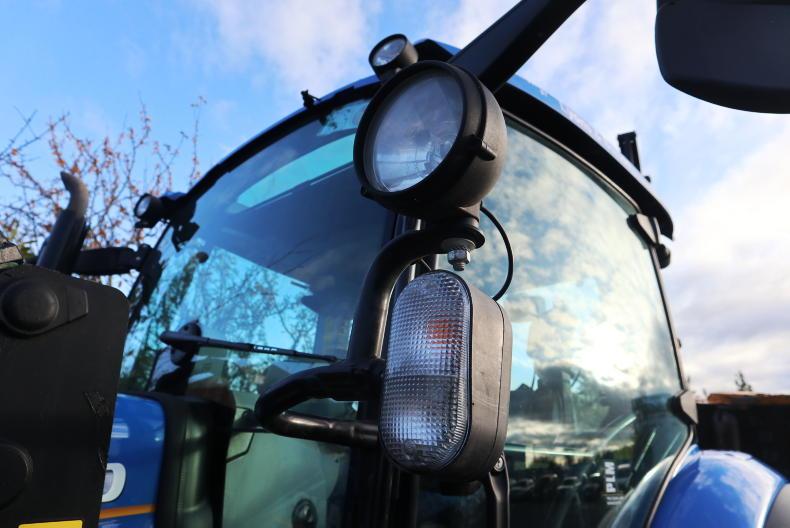
It goes without saying all lights should be working and glassware kept clean.
4 Backend
With tractors, it is important that the backend is given the once over. Check the condition of the pickup hitch (especially if in regular use) and that no bolts have become loose.
Check that the U-guard is intact and not damaged. Check the PTO seal for leaks and that hydraulic couplings are all working and not leaking either.
A leak will not only eventually drain the tractor of oil, but will drip down the backend, leaving ideal conditions for dirt and dust to stick to.
Hydraulic filters can often be forgotten about. Make a point of checking when these were last changed and replace if necessary.
It is important that stabilisers are present and not seized for the safe transport of loads. Any damaged component should be replaced or repaired ASAP.
5 Loader, linkages and
implements
All lubrication points, whether it be an implement, wheel loader or front loader, should be regularly greased to reduce wear, especially loaders where there are numerous pivot points and linkages. Hubs and oscillation points should also receive adequate grease.
Check hydraulic hoses and fittings, as well as brackets and headstocks for signs of wear or damage and act accordingly.
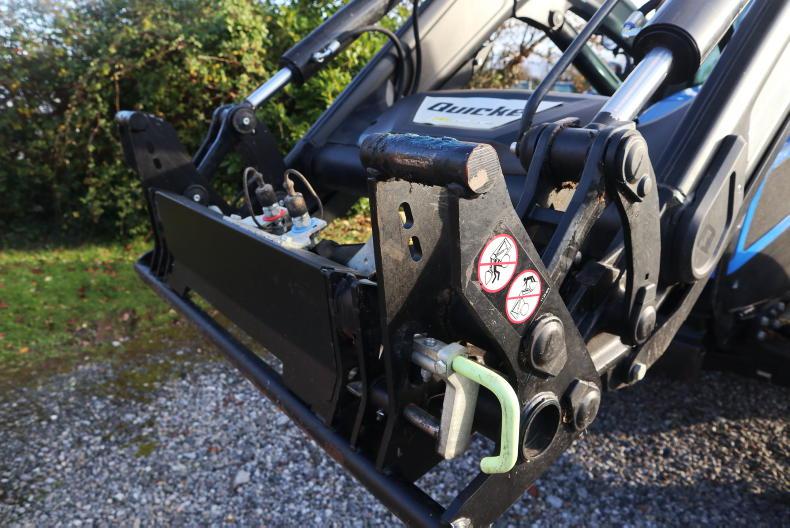
The front loader should be checked for wear and greased regularly.
All implements should also be checked closely for wear or damage too. Implements such as shear grabs should also be regularly greased and correctly maintained.
6 Brakes, tyres and steering
Both brake and handbrake condition should be assessed. Brakes with poor response need repair. Delaying or ignoring repair can lead to further mechanical problems within a tractor’s hydraulic system alongside serious safety issues.
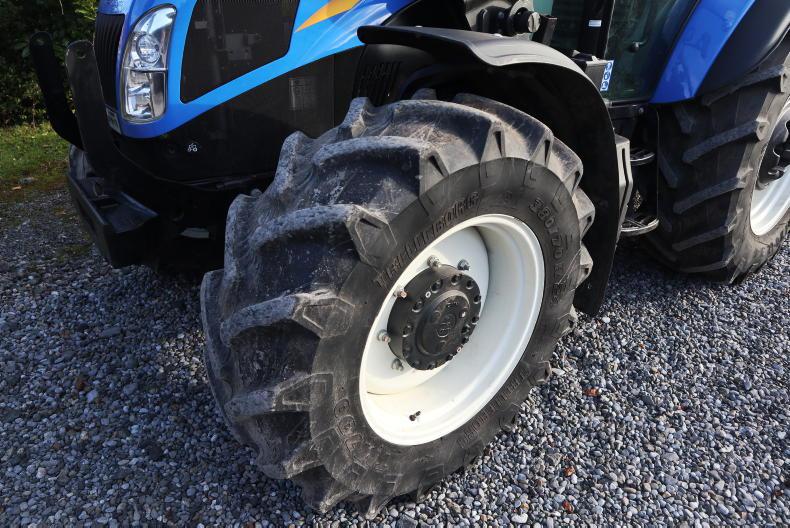
Tyres should be properly inflated with no bad cracks or extreme wear.
All tyres should be examined for dangerous cuts and that they are inflated to the correct pressures for the particular application. Tractors fitted with front loaders will be subject to greater loads, so inflate tyre pressure accordingly.
As with any machine, it pays to be proactive rather than reactive, not only financially but from a safety viewpoint too.
With the wintry weather not forecast to go away anytime soon and many farmers in the throes of calving season, machinery is under as much or more pressure than it has been all winter.
A functional, reliable tractor or wheel loader is vital in ensuring the smooth day-to-day running of any farm.
Often, it is during the busy winter period when issues or breakages can go unnoticed.
It is important that time is allocated at some point on a routine basis to carry out maintenance on winter machinery.
The potential consequences of poor maintenance can be catastrophic and lead to lengthy machine downtime.
Below is a guide on things one should consider when it comes to ensuring that these pivotal machines see the winter feeding season through.
1 Engine and cooling system
The engine and cooling system is always a good location to start when checking over any machine. Ensure the tractor or loader is on level ground and stopped for some time to cool, pull the bonnet and start by checking fluid levels, including engine oil and back end (hydraulic) oil. If your engine is due an oil and filter change, then now might be the time to do it.
Make a point of paying particular attention to your engine’s cooling system as this is often an area overlooked by many. Examine the condition of the water pump, fan belt (condition and tension), rubber hoses and the expansion tank or reservoir.
Check that there are no traces of oil in the expansion tank, as this would indicate head gasket failure.
Modern cooling systems use coolant, which not only helps keep the engine cool but stops the system from freezing. Coolant helps prevent corrosion, lubricates shaft seals and inhibits cavitation of components. Cooling systems on older machines may use an anti-freeze and water mix.
If in doubt about when coolant or anti-freeze was last replaced or if in excess of 12 months, it is advisable to drain and replenish. Coolant is typically a readymade solution that does not require watering down, while anti-freeze is generally a concentrate solution requiring water to be added. 
Coolant level should be checked regularly and replaced annually.
Dirty or rusty coolant indicates corrosion in the system, meaning that this particular property of the solution is no longer active, leaving the water pump susceptible to damage. It is not advised to mix different brands of coolants, as a chemical reaction could occur affecting its properties or even cause a sludge to form.
Also, check the radiator’s cleanliness regularly, as fins can become blocked with dirt and dust over time. Remove debris and blow out with an air compressor if necessary.
2 Fuel and AdBlue
Fuel filters should be replaced at the recommended intervals and the water separator drained regularly.
Fuel filters may need to be changed more frequently, depending on fuel quality. If you find this to be the case, it is worth fitting your bulk diesel tank with a pre-filter to remove major contaminants before fuel even enters the tractor or loader’s tank.
For those operating modern machinery using AdBlue, ensure the tank isn’t left full during frosty weather as a precaution. This is because the fluid can expand by up to 7%, so room for expansion is required to prevent its tank cracking. AdBlue can freeze and thaw without affecting its functionality.
During frosty periods it is advised to only half fill machinery with AdBlue as it can expand up to 7%.
3 Battery, lighting and cab
Give the battery a quick check over, ensuring terminals are tight and free from cracks and corrosion. Any corrosion should be removed using baking soda and an abrasive brush (pole brush).
During the winter period, machines tend to run for short durations and often with lights on due to the darker days. After a period of time, the battery may lose more power than the alternator can regenerate during the time the engine runs. Before long, this will result in a flat battery.
If you find this happening, try to run the machine for longer periods every so often to charge the battery. 
Ensure battery terminals are corrosion-free and tight.
Ensure steps are in good order and debris-free, reducing your chances of slipping or falling upon entry or exit. The cab floor should be free from clutter, while all dials, switches and control instruments should be intact and functional.
Not only is it important that the heater is functional to keep the operator warm, but also to remove condensation from windows. 
The controls should be functional and the cab clutter-free.
We are all guilty of dirty glassware. Take the time to clean all windows and mirrors. Doing this will lead to improvements in visibility. Equally, ensure the wipers are working and that the blade isn’t worn. A worn-out blade will only scratch the windscreen. The windscreen washer system, where fitted, should be operational with a small amount of anti-freeze added during the cold winter period to thaw the window and prevent the storage tank from freezing and cracking.
All lights and glassware should be intact and functional. By law, at least one beacon should be present and working if travelling on public roads. 
It goes without saying all lights should be working and glassware kept clean.
4 Backend
With tractors, it is important that the backend is given the once over. Check the condition of the pickup hitch (especially if in regular use) and that no bolts have become loose.
Check that the U-guard is intact and not damaged. Check the PTO seal for leaks and that hydraulic couplings are all working and not leaking either.
A leak will not only eventually drain the tractor of oil, but will drip down the backend, leaving ideal conditions for dirt and dust to stick to.
Hydraulic filters can often be forgotten about. Make a point of checking when these were last changed and replace if necessary.
It is important that stabilisers are present and not seized for the safe transport of loads. Any damaged component should be replaced or repaired ASAP.
5 Loader, linkages and
implements
All lubrication points, whether it be an implement, wheel loader or front loader, should be regularly greased to reduce wear, especially loaders where there are numerous pivot points and linkages. Hubs and oscillation points should also receive adequate grease.
Check hydraulic hoses and fittings, as well as brackets and headstocks for signs of wear or damage and act accordingly.

The front loader should be checked for wear and greased regularly.
All implements should also be checked closely for wear or damage too. Implements such as shear grabs should also be regularly greased and correctly maintained.
6 Brakes, tyres and steering
Both brake and handbrake condition should be assessed. Brakes with poor response need repair. Delaying or ignoring repair can lead to further mechanical problems within a tractor’s hydraulic system alongside serious safety issues.

Tyres should be properly inflated with no bad cracks or extreme wear.
All tyres should be examined for dangerous cuts and that they are inflated to the correct pressures for the particular application. Tractors fitted with front loaders will be subject to greater loads, so inflate tyre pressure accordingly.
As with any machine, it pays to be proactive rather than reactive, not only financially but from a safety viewpoint too.













 This is a subscriber-only article
This is a subscriber-only article











SHARING OPTIONS: